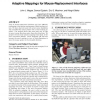Free Online Productivity Tools
i2Speak
i2Symbol
i2OCR
iTex2Img
iWeb2Print
iWeb2Shot
i2Type
iPdf2Split
iPdf2Merge
i2Bopomofo
i2Arabic
i2Style
i2Image
i2PDF
iLatex2Rtf
Sci2ools
ASSETS
2010
ACM
2010
ACM
Adaptive mappings for mouse-replacement interfaces
Users of mouse-replacement interfaces may have difficulty conforming to the motion requirements of their interface system. We have observed users with severe motor disabilities who controlled the mouse pointer with a head tracking interface. Our analysis shows that some users may be able to move in some directions easier than other directions. We propose several mouse pointer mappings that adapt to the user's movement abilities. These mappings will take into account the user's motions in two- or three-dimensions to move the mouse pointer in the intended direction. Categories and Subject Descriptors
ASSETS 2010 | Emerging Technology | Mouse Pointer | Mouse Pointer Mappings | Severe Motor Disabilities |
| Added | 05 Dec 2010 |
| Updated | 05 Dec 2010 |
| Type | Conference |
| Year | 2010 |
| Where | ASSETS |
| Authors | John J. Magee, Samuel Epstein, Eric S. Missimer, Margrit Betke |
Comments (0)

